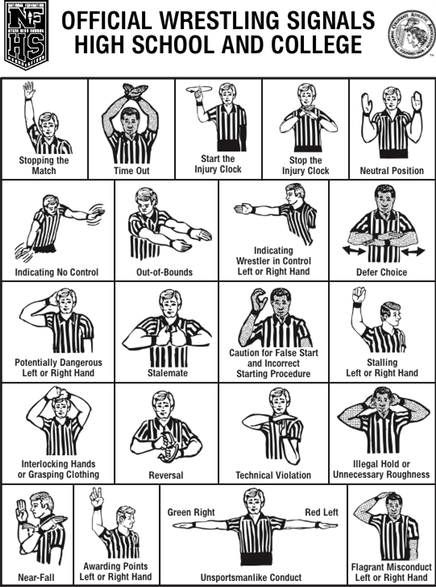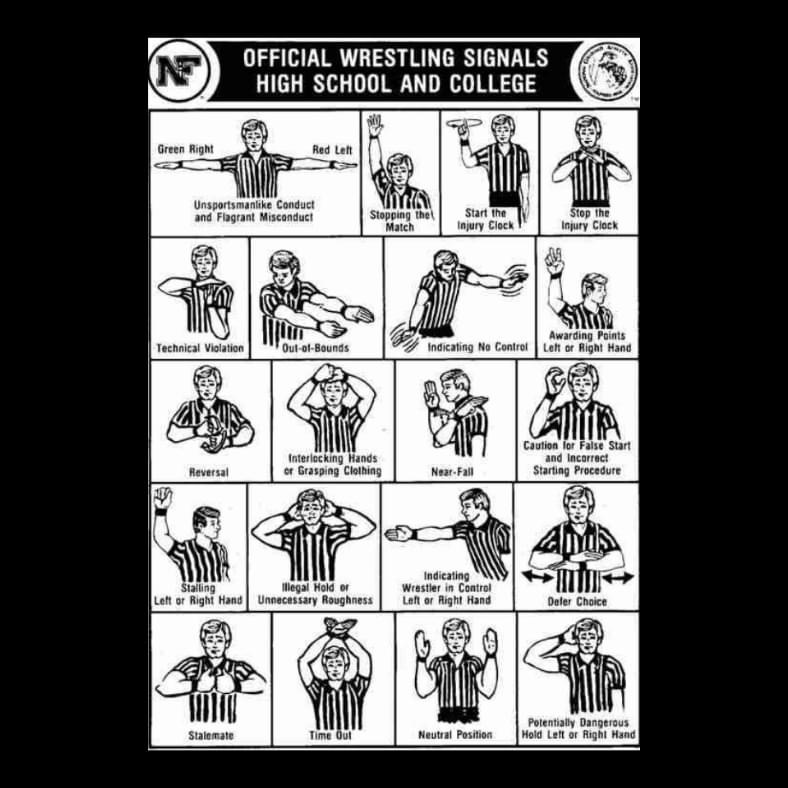If you’ve ever watched a high school wrestling match, you’ve noticed referees making a series of hand gestures throughout the bout. These aren’t random. They’re a crucial part of the sport, ensuring that everyone involved understands what’s happening, from the wrestlers on the mat to the spectators in the stands.
Clear communication is vital in such an action-packed and fast-paced environment. Every movement and decision can change the outcome of a match. And that’s where hand signals come into play. They are the silent, yet loud language of wrestling officiating, conveying scores, penalties, and other decisions in real-time.
More than just indicating points and penalties, these hand signals enhance the safety and fairness of the sport. Wrestlers need to know instantly if a hold is illegal or if they’re in a potentially dangerous position. Similarly, coaches and teammates look to the referee’s signals to understand how to advise their wrestler during a match.
A referee’s role is not just about maintaining order; it involves quick judgment and the ability to communicate those decisions effectively. The use of hand signals cuts through the noise and action, delivering an unmistakable message to everyone watching.
As we step into the next section, we’re going to get a closer look into the hand signals you might see a referee use during a high school wrestling match. I’ll tell you about the common gestures for starting positions, scoring moves, penalties, and much more. So you won’t just watch the action; you’ll understand the narrative unfolding before your eyes.
Decoding the Referee’s Gestures: A Guide to Common High School Wrestling Signals

If you’ve ever watched a high school wrestling match, you’ll notice that the referee is constantly on the move, using their hands to communicate different actions and rulings. These hand signals are the universal language of wrestling, ensuring that everyone – from wrestlers to coaches, to the spectators – understands what’s happening on the mat. Let’s break down some of the most essential signals.
A match starts with positioning wrestlers facing each other, and the referee’s arm chop, indicating the commencement. When a wrestler successfully takes down an opponent, the referee will raise a hand with fingers extended to signal the number of points awarded, usually two for a takedown. The thrill of reversal is captured when the referee switches the extended hand, marking a change in control and awarding points to the now-dominant wrestler.
Escapes are just as crucial, and when a wrestler breaks free, the referee indicates this with one arm shooting upwards. This usually signifies one point to the escaping wrestler. Near falls, where a wrestler almost pins their opponent but doesn’t quite get there, are signaled with the referee holding two fingers out, indicating back points are being counted.
Unfortunately, penalties are part of the sport. When a wrestler is stalling or uses an illegal hold, the referee will signal the specific infraction with a series of hand gestures that mimic the foul. For stalling, it’s often a circular motion with one hand, akin to saying ‘Let’s keep things moving!’
Out-of-bounds calls and stoppages play a huge role in the momentum of the match. The referee will signal wrestlers are out-of-bounds by sweeping arms and crossing them in front. For injuries, time-outs, or other stoppages, the referee will blow the whistle and raise a fist.
As the period ends, you’ll see the referee hold up fingers to indicate which round just concluded. When the final buzzer sounds, the ‘winning’ hand signal is raised – a triumphant, skyward pointing gesture that signals the victor of the match, providing a clear, definitive conclusion.
Remember, each gesture plays a pivotal part in communicating the ongoing narrative of the match. In the next section, I’m going to help turn you from a casual observer into a knowledgeable wrestling aficionado as we go over how to further enhance your experience as a spectator by understanding the nuance and strategy conveyed by referee hand signals.
From Spectator to Expert: Enhancing Your Viewing Experience with Knowledge of Referee Signals

Now that you’re familiar with the hand signals and what they signify, you’re all set to watch a high school wrestling match with a keen eye. Understanding these signals isn’t just for coaches and athletes; it’s incredibly enriching for spectators too. Picture yourself in the stands, calling the moves and points before they’re even announced. That’s going to include a level of involvement that transforms your viewing experience from passive to active.
Parents and friends on the sidelines are often the biggest supporters of wrestlers. I really hope that you take this newfound knowledge to the matches and use it to cheer even louder for your favorite athletes. It may seem daunting at first, but with a little practice, you’ll find that recognizing these signals becomes second nature.
Choose something that resonates with you from these insights and share it with others who might appreciate the sport even more with this information. This isn’t just about increasing your enjoyment; it’s also about building a supportive community around the wrestlers.
For those eager to dive even deeper into the sport, there’s a lot of opportunity in attending local referee clinics or reviewing educational materials from wrestling organizations. So, the next time you find yourself watching a wrestling match, remember you’re equipped not just to observe, but to participate in the silent dialogue of competition. Thanks for taking the time to learn about high school wrestling referee hand signals, and I’m here to help you with any further questions!

